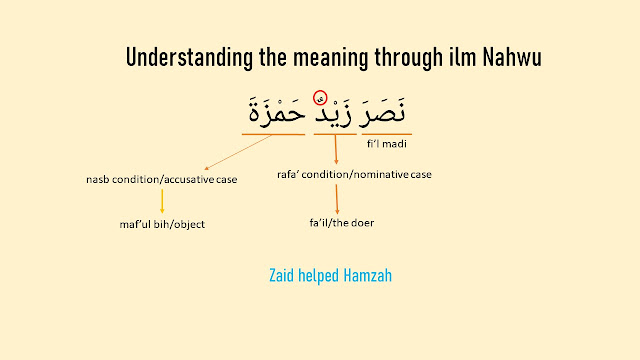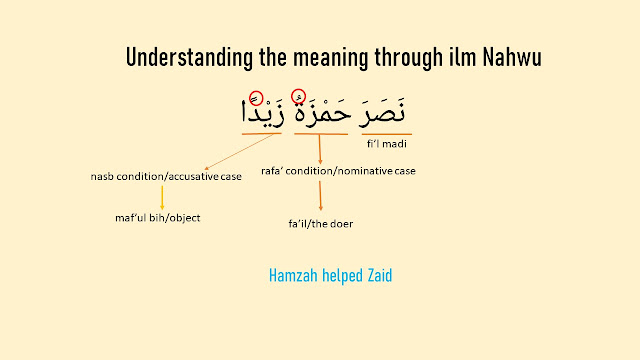From Ambiguity to Clarity: The Power of Nahwu in Arabic Sentence Structure
The essence of ilm nahwu
The essence of nahwu is how do you know the condition of the harakat on the final letter of a word.
Knowing the final harakat of a word helps determine its position in a sentence, whether it acts as the subject, object, or in another role.
So, knowing the harakat at the end of a word can help determine its grammatical function in the sentence, which can influence the overall meaning of the sentence.
How harakat helps us understand an Arabic sentence
Let's see how harakat helps us understand the sentence: "نصر زيد حمزة "
Without harakat, the sentence can be ambiguous.
Without explicit diacritical marks, or “harakat”, it’s impossible to ascertain who performed the action of “helping” in the above sentence.
Understanding the precise meaning necessitates a thorough examination of the sentence’s context. This could involve analyzing preceding or succeeding sentences.
In the absence of such context, the sentence could be interpreted in two ways:
1. Zaid helped Hamzah.
2. Hamzah helped Zaid.
Key takeaway: Harakat are essential for accurate understanding of Arabic sentences, especially when word order alone doesn't distinguish subject and object clearly.
Why does the sentence above have two meanings?
Word Order and Harakat in Arabic
Arabic is known for its flexible word order. This means the position of the subject (actor) and object can vary in a sentence. However, unlike English where word order is crucial for meaning, Arabic relies on another feature: harakat.
Harakat: The Vowel Markings
Harakat are diacritical marks placed above or below letters. They indicate short vowels that aren't inherently shown in Arabic script. These markings are essential for understanding the grammatical function of each word.
How Harakat Clarify Meaning?
By indicating if a word is a subject, object, or something else, harakat resolve the ambiguity caused by flexible word order. They also influence verb conjugation based on tense and subject.
In conclusion, while word order offers some flexibility, harakat play a critical role in pinpointing the exact meaning of Arabic sentences. They ensure accurate understanding of a sentence's structure and meaning.
Now, please look at the sentence above with the complete harakat markings.
Sentence with complete harakat markings Examples
1. نَصَرَ زَيْدٌ حَمْزَةَ
2. نَصَرَ زَيْدًا حَمْزَةُ
3. نَصَرَ حَمْزَةُ زَيْدًا
The meaning and explanation of the three sentences above:
The meaning
1. نَصَرَ زَيْدٌ حَمْزَةَ
Meaning: Zaid helped Hamzah.
2. نَصَرَ زَيْدًا حَمْزَةُ
Meaning: Hamzah helped Zaid.
3. نَصَرَ حَمْزَةُ زَيْدًا
Meaning: Hamzah helped Zaid.
Explanation
1. نَصَرَ زَيْدٌ حَمْزَةَ
a. نَصَرَ : fi'l madi for the third person masculine singular.
b. زَيْدٌ : the final harakat is a dammah "u", therefore it is فَاعِل (the doer or one who hits).
c. حَمْزَةَ : the final harakat is fat-hah "a", therefore it is مفعول به (object).
So the meaning of sentence number 1 is "Zaid helped Hamzah".
2. نَصَرَ زَيْدًا حَمْزَةُ
a. نَصَرَ : fi'l madi for the third person masculine singular.
b. زَيْدًا : the final harakat is fat-hah "a", therefore it is مفعول به (object).
c. حَمْزَةُ : the final harakat is dammah "u", therefore it is فَاعِل (the actor or the one who hits).
So, the meaning of sentence number 2 is "Hamzah helped Zaid".
3. نَصَرَ حَمْزَةُ زَيْدًا
a. نَصَرَ : fi'l madi for the third person masculine singular.
b. حَمْزَةُ : the final harakat is dammah "u", therefore it is فَاعِل (the doer or one who hits).
c. زَيْدًا : the final harakat is fat-hah "a", therefore it is مفعول به (object).
So, the meaning of sentence number 3 is "Hamzah helped Zaid".
You will learn the above in the next lesson. This first lesson is just an introduction to the importance of nahwu.
In the next lesson you will learn about the conditions under which the final harakat of a word changes, namely rafa', nasb, jar, and jazm.
Practice Questions
1. Look at the following sentence:
ينصر محمّد زيدا
What does the sentence above mean?
Explain the steps in translating the sentence above.
2. What is the essence of the science of nahwu?
3. Consider the following statement:
The order of words in a sentence determines the meaning of the sentence.
Is this statement true?
Explain your answer with an example sentence.






No comments:
Post a Comment